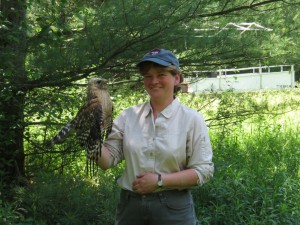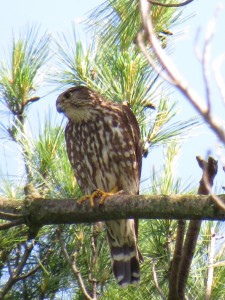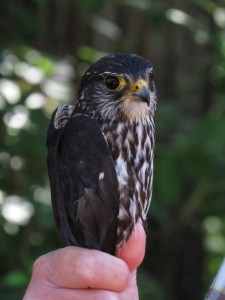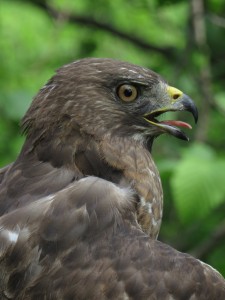July 29, 2015 at 4:44 pm
[caption id="attachment_848" align="alignright" width="300"] IFW Biologist and occasional IFW blogger Amy Meehan with a red-shouldered hawk.[/caption]
Raptors, or birds of prey, are some of the most fascinating and beautiful birds in the world. This group includes Eagles, Vultures, Hawks, Kites, Osprey, Falcons and Owls. I recently had the incredible opportunity to attend a week-long workshop called “Raptor Field Techniques” in Stevens Point, Wisconsin. The workshop was presented by Eugene Jacobs of Linwood Springs Research Station. Gene is a raptor expert, who has over 40 years of experience in studying, capturing, and handling raptors.
[caption id="attachment_853" align="alignleft" width="225"]
IFW Biologist and occasional IFW blogger Amy Meehan with a red-shouldered hawk.[/caption]
Raptors, or birds of prey, are some of the most fascinating and beautiful birds in the world. This group includes Eagles, Vultures, Hawks, Kites, Osprey, Falcons and Owls. I recently had the incredible opportunity to attend a week-long workshop called “Raptor Field Techniques” in Stevens Point, Wisconsin. The workshop was presented by Eugene Jacobs of Linwood Springs Research Station. Gene is a raptor expert, who has over 40 years of experience in studying, capturing, and handling raptors.
[caption id="attachment_853" align="alignleft" width="225"] A female merlin strikes a watchful eye (IFW photo by Amy Meehan)[/caption]
Because of their sharp talons and beaks, handling raptors presents unique challenges, so the workshop emphasized “hands-on” learning. We participated in on-going studies, and each day we went into the field and captured and handled various species of raptors, including Red-shouldered Hawks, Broad-winged Hawks, Kestrels and Merlins; all of which we have here in Maine.
[caption id="attachment_854" align="alignright" width="225"]
A female merlin strikes a watchful eye (IFW photo by Amy Meehan)[/caption]
Because of their sharp talons and beaks, handling raptors presents unique challenges, so the workshop emphasized “hands-on” learning. We participated in on-going studies, and each day we went into the field and captured and handled various species of raptors, including Red-shouldered Hawks, Broad-winged Hawks, Kestrels and Merlins; all of which we have here in Maine.
[caption id="attachment_854" align="alignright" width="225"] This small merlin is slightly larger than a kestrel. Their diet consists mainly of other smaller birds, and they often will hunt in pairs. (IFW photo by Amy Meehan)[/caption]
Each participant received experience in removing birds from the nets (without getting impaled by a talon), handling the birds, banding and reading molt (this helps to age the bird, by figuring out which feathers it has molted and replaced).
The workshop covered a multitude of other subjects including blood-sampling, telemetry, broadcast call survey techniques (this is where you play the call of the bird to see if it responds); permits, publications, and regulations; and even tree climbing and rappelling. Even the two of us who are afraid of heights plucked up the courage to at least climb a few feet up the tree in Gene’s yard! We also got a chance to handle a Great-horned Owl that is in permanent captivity
[caption id="attachment_849" align="alignleft" width="225"]
This small merlin is slightly larger than a kestrel. Their diet consists mainly of other smaller birds, and they often will hunt in pairs. (IFW photo by Amy Meehan)[/caption]
Each participant received experience in removing birds from the nets (without getting impaled by a talon), handling the birds, banding and reading molt (this helps to age the bird, by figuring out which feathers it has molted and replaced).
The workshop covered a multitude of other subjects including blood-sampling, telemetry, broadcast call survey techniques (this is where you play the call of the bird to see if it responds); permits, publications, and regulations; and even tree climbing and rappelling. Even the two of us who are afraid of heights plucked up the courage to at least climb a few feet up the tree in Gene’s yard! We also got a chance to handle a Great-horned Owl that is in permanent captivity
[caption id="attachment_849" align="alignleft" width="225"] Eye to eye with a broad-winged hawk. (IFW photo by Amy Meehan)[/caption]
following several injuries from a vehicle strike. She is now used for education purposes. Her name is Sassy. Enough said!
The male Merlin that we captured on the last day of the workshop had already been banded. Gene will contact the Bird Banding Laboratory at the Patuxent Wildlife Research Center and be able to find out who banded it, where it was banded and at what age it was banded. He will also report where we captured it, and its current age. Data like these are used to study various parts of bird life history such as dispersal and migration, behavior, social structure, life-span, survival, reproductive success and population growth.
For more information about raptors, you can visit the Raptor Research Foundation’s website: http://www.raptorresearchfoundation.org/
[caption id="attachment_852" align="aligncenter" width="871"]
Eye to eye with a broad-winged hawk. (IFW photo by Amy Meehan)[/caption]
following several injuries from a vehicle strike. She is now used for education purposes. Her name is Sassy. Enough said!
The male Merlin that we captured on the last day of the workshop had already been banded. Gene will contact the Bird Banding Laboratory at the Patuxent Wildlife Research Center and be able to find out who banded it, where it was banded and at what age it was banded. He will also report where we captured it, and its current age. Data like these are used to study various parts of bird life history such as dispersal and migration, behavior, social structure, life-span, survival, reproductive success and population growth.
For more information about raptors, you can visit the Raptor Research Foundation’s website: http://www.raptorresearchfoundation.org/
[caption id="attachment_852" align="aligncenter" width="871"] A group of kestrel chicks (IFW Photo by Amy Meehan)[/caption]
A group of kestrel chicks (IFW Photo by Amy Meehan)[/caption]
 IFW Biologist and occasional IFW blogger Amy Meehan with a red-shouldered hawk.[/caption]
Raptors, or birds of prey, are some of the most fascinating and beautiful birds in the world. This group includes Eagles, Vultures, Hawks, Kites, Osprey, Falcons and Owls. I recently had the incredible opportunity to attend a week-long workshop called “Raptor Field Techniques” in Stevens Point, Wisconsin. The workshop was presented by Eugene Jacobs of Linwood Springs Research Station. Gene is a raptor expert, who has over 40 years of experience in studying, capturing, and handling raptors.
[caption id="attachment_853" align="alignleft" width="225"]
IFW Biologist and occasional IFW blogger Amy Meehan with a red-shouldered hawk.[/caption]
Raptors, or birds of prey, are some of the most fascinating and beautiful birds in the world. This group includes Eagles, Vultures, Hawks, Kites, Osprey, Falcons and Owls. I recently had the incredible opportunity to attend a week-long workshop called “Raptor Field Techniques” in Stevens Point, Wisconsin. The workshop was presented by Eugene Jacobs of Linwood Springs Research Station. Gene is a raptor expert, who has over 40 years of experience in studying, capturing, and handling raptors.
[caption id="attachment_853" align="alignleft" width="225"] A female merlin strikes a watchful eye (IFW photo by Amy Meehan)[/caption]
Because of their sharp talons and beaks, handling raptors presents unique challenges, so the workshop emphasized “hands-on” learning. We participated in on-going studies, and each day we went into the field and captured and handled various species of raptors, including Red-shouldered Hawks, Broad-winged Hawks, Kestrels and Merlins; all of which we have here in Maine.
[caption id="attachment_854" align="alignright" width="225"]
A female merlin strikes a watchful eye (IFW photo by Amy Meehan)[/caption]
Because of their sharp talons and beaks, handling raptors presents unique challenges, so the workshop emphasized “hands-on” learning. We participated in on-going studies, and each day we went into the field and captured and handled various species of raptors, including Red-shouldered Hawks, Broad-winged Hawks, Kestrels and Merlins; all of which we have here in Maine.
[caption id="attachment_854" align="alignright" width="225"] This small merlin is slightly larger than a kestrel. Their diet consists mainly of other smaller birds, and they often will hunt in pairs. (IFW photo by Amy Meehan)[/caption]
Each participant received experience in removing birds from the nets (without getting impaled by a talon), handling the birds, banding and reading molt (this helps to age the bird, by figuring out which feathers it has molted and replaced).
The workshop covered a multitude of other subjects including blood-sampling, telemetry, broadcast call survey techniques (this is where you play the call of the bird to see if it responds); permits, publications, and regulations; and even tree climbing and rappelling. Even the two of us who are afraid of heights plucked up the courage to at least climb a few feet up the tree in Gene’s yard! We also got a chance to handle a Great-horned Owl that is in permanent captivity
[caption id="attachment_849" align="alignleft" width="225"]
This small merlin is slightly larger than a kestrel. Their diet consists mainly of other smaller birds, and they often will hunt in pairs. (IFW photo by Amy Meehan)[/caption]
Each participant received experience in removing birds from the nets (without getting impaled by a talon), handling the birds, banding and reading molt (this helps to age the bird, by figuring out which feathers it has molted and replaced).
The workshop covered a multitude of other subjects including blood-sampling, telemetry, broadcast call survey techniques (this is where you play the call of the bird to see if it responds); permits, publications, and regulations; and even tree climbing and rappelling. Even the two of us who are afraid of heights plucked up the courage to at least climb a few feet up the tree in Gene’s yard! We also got a chance to handle a Great-horned Owl that is in permanent captivity
[caption id="attachment_849" align="alignleft" width="225"] Eye to eye with a broad-winged hawk. (IFW photo by Amy Meehan)[/caption]
following several injuries from a vehicle strike. She is now used for education purposes. Her name is Sassy. Enough said!
The male Merlin that we captured on the last day of the workshop had already been banded. Gene will contact the Bird Banding Laboratory at the Patuxent Wildlife Research Center and be able to find out who banded it, where it was banded and at what age it was banded. He will also report where we captured it, and its current age. Data like these are used to study various parts of bird life history such as dispersal and migration, behavior, social structure, life-span, survival, reproductive success and population growth.
For more information about raptors, you can visit the Raptor Research Foundation’s website: http://www.raptorresearchfoundation.org/
[caption id="attachment_852" align="aligncenter" width="871"]
Eye to eye with a broad-winged hawk. (IFW photo by Amy Meehan)[/caption]
following several injuries from a vehicle strike. She is now used for education purposes. Her name is Sassy. Enough said!
The male Merlin that we captured on the last day of the workshop had already been banded. Gene will contact the Bird Banding Laboratory at the Patuxent Wildlife Research Center and be able to find out who banded it, where it was banded and at what age it was banded. He will also report where we captured it, and its current age. Data like these are used to study various parts of bird life history such as dispersal and migration, behavior, social structure, life-span, survival, reproductive success and population growth.
For more information about raptors, you can visit the Raptor Research Foundation’s website: http://www.raptorresearchfoundation.org/
[caption id="attachment_852" align="aligncenter" width="871"] A group of kestrel chicks (IFW Photo by Amy Meehan)[/caption]
A group of kestrel chicks (IFW Photo by Amy Meehan)[/caption]
Categories